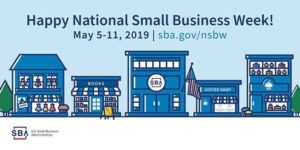#smallbusinessweek Trademark 101

By Mara Trumbour
Most entrepreneurs know that trademarking is an important first step in starting a business–but how much do they really know about trademarks? To help protect the brand you’ve worked hard to establish, it’s important to understand the ins and outs of trademarks and trademark protection. I’ve broken down some of the most common trademark misconceptions every business owner should know.
If I own the website domain name, I automatically own the trademark → FICTION.
Don’t let this fool you – a website domain is different from a trademark and therefore securing a website address does not protect your business. Even if you have a website domain secured, you’ll still need to register your trademark with the U.S. Patent and Trademark Office and then continue to monitor it for full protection.
The symbols ™ and ® are not interchangeable → FACT.
The differentiation between these symbols is something that is often easily confused. The ™ symbol should be used while a trademark registration application is pending, or if you have established common law rights. The ® symbol can be used once your trademark is federally registered.
Once I register, the Trademark Office (USPTO) will make sure my trademark isn’t violated → FICTION.
Once you own the rights to a mark, you’re responsible for enforcement. The USPTO will attempt to ensure no one receives registrations for a similar mark but it is ultimately up to you to consistently and indefinitely monitor your mark, then take action if need be. And there’s no room for slacking! It’s imperative to police your mark in a timely fashion as you only have 30 days to oppose copycats.
Trademarks have commercial value → FACT.
Trademarks can hold monetary value because they represent consumer recognition and goodwill. For example, companies may list their trademark applications and registrations as collateral to secure a loan. Similar to brand valuation, the worth of a trademark can be estimated as expected future economic benefit from products or services sold under the trademark, by market value, or by costs associated with registration and maintenance.
Any mark can be registered → FICTION.
Unfortunately, not every mark is registrable with the USPTO. Before choosing a mark for your business, product or service, it’s crucial to do some digging to see if your trademark may be difficult or impossible to register. In doing so, the USPTO suggests you consider whether your mark is likely to be confused with any pre-existing ones, and how easy it will be to protect from copycats. “Weak” marks are descriptive (for example, “Creamy” for frozen yogurt) and likely in use by others, making it difficult and costly to try to police them. “Strong” marks most easily allow you to prevent unauthorized use of your mark and are very distinct. The more creative and unusual the mark, the less likely that others are also using it. There are additional reasons why the USPTO will also refuse registration of a proposed mark including: if the mark is a surname, geographically descriptive of the origin of the product, disparaging or offensive, a foreign term that translates to a descriptive or generic term, an individual’s name or likeness, or the title of a single book and/or movie.
Mara Trumbour is the Executive Product Owner of Trademark.com and has extensive experience with intellectual property solutions. Based in Boston, Massachusetts, Mara is responsible for the development and execution of Trademark.com’s business strategy. She holds an MBA with a concentration in marketing from Bentley University.
Registered symbol stock photo by MR Gao/Shutterstock







